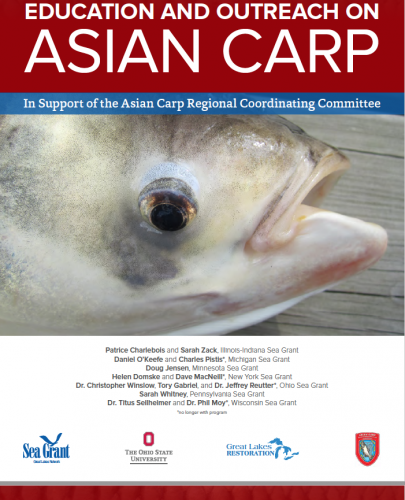Sea Grant report on Asian carp includes educational resources
Great Lakes conservation groups will find a wealth of resources in this new publication.

The Great Lakes Sea Grant Network, in support of the Asian Carp Regional Coordinating Committee, just released a report that contains a variety of resources for anyone working on education and outreach related to Asian carp. The report contains sections that provide basic information in addition to helping readers sift through the large amount of information available to find the best outreach products for their audience.
Understanding the threat
The new report details the four species of Asian carp that pose a threat to Great Lakes waters: Bighead Carp, Silver Carp, Black Carp, and Grass Carp. Each species is a concern, but Bighead Carp and Silver Carp get the most attention because they are filter feeders that eat plankton. This could result in direct competition with native gamefish or indirect effects if baitfish populations are harmed. Scientists are now employing a variety of techniques to learn more about these fish, and the report explains some of the headline-grabbing methods like eDNA monitoring and DIDSON sonar imaging.
Educational resources
The Sea Grant report includes a state-by-state list of fact sheets, articles, brochures, posters, online videos, and other materials related to Asian carp outreach. This is a great place to start if you are looking for materials to distribute at a boat show, club meeting, or other event. In the “Analysis of Education and Outreach” section, the report provides a quick reference chart that organizes materials by audience and message.
PowerPoint Presentation
In addition to a list of available materials, the report includes a set of slides that can be downloaded and used by educators around the Great Lakes region. Slides include basic life history information for each species, potential for economic and ecological harm, control attempts, and an overview of existing research and research gaps. Each slide contains comprehensive presenter notes, and the slide set can be modified to suit your audience.
Michigan Sea Grant helps to foster economic growth and protect Michigan’s coastal, Great Lakes resources through education, research and outreach. A collaborative effort of the University of Michigan and Michigan State University and its MSU Extension, Michigan Sea Grant is part of the NOAA-National Sea Grant network of 33 university-based programs.



 Print
Print Email
Email



